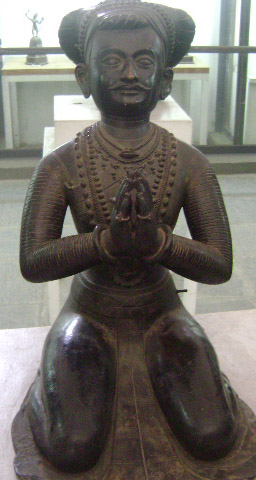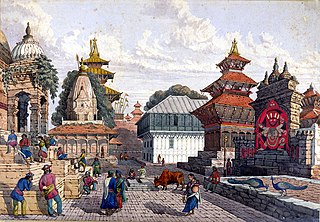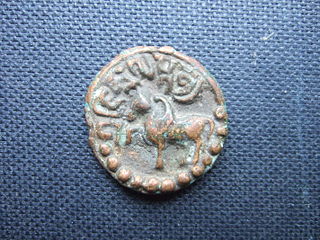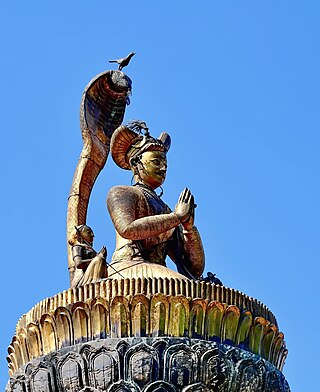
Chandragupta I was a king of the Gupta Empire, who ruled in northern and central India. His title Mahārājadhirāja suggests that he was the first emperor of the dynasty. It is not certain how he turned his small ancestral kingdom into an empire, although a widely accepted theory among modern historians is that his marriage to the Licchavi princess Kumaradevi helped him extend his political power. Their son Samudragupta further expanded the Gupta empire.

The Licchavis of Nepal was a kingdom which existed in the Kathmandu Valley, Nepal from approximately 450 CE to 750 CE. The Licchavi clan originated from a branch of Licchavis of Vaishali who ruled in the territory of modern-day Bihar and who later conquered the Kathmandu Valley. The Licchavis were ruled by a maharaja, aided by a prime minister and other royal officials, but in practice local communities were controlled by caste councils.

Amshuverma or Amshu Verma was a king of Nepal from around 605–621 CE. Initially a feudal lord, he rose to the position of Mahasamanta in about 598 CE when Shivadeva I of the Licchavi dynasty was the ruling monarch and by 604, Shivadeva was reduced to a mere figurehead. He is considered to have died in 621 AD and was succeeded by Udaydeva, the son of Shivadeva I.

Buddhism in Nepal started spreading since the reign of Ashoka through Indian and Tibetan missionaries. The Kiratas were the first people in Nepal who embraced the Buddha’s teachings, followed by the Licchavis and Newar people. Buddhism is Nepal's second-largest religion, with 8.2% of the country's population, or approximately 2.4 million people, identifying as adherents of Buddhism in a 2021 census.
Arimalla, also known as Aridev Malla, was the first king of the Malla dynasty in the Kathmandu valley, also known as Nepal Mandala at that time.
Samanta was a title and position used in the history of the Indian subcontinent between 4th and 12th century to denote a vassal, feudal lord or tributary chief. The leader of 100 village also popularly known as jagirdar. The term roughly translates to neighbor. The institution is considered to be closely associated with the origin and growth of feudalism in India and Medieval India.

The Malla dynasty also known as the Malla confederacy, was the ruling dynasty of the Kathmandu Valley in Nepal from 1201 to 1779. This dynasty was founded by Arideva Malla. Though the latter Mallas were regarded as belonging to the Raghuvamsha dynasty, they were also seen as continuations and descendants of the Licchavi dynasty. Later Malla kings also traced one section of their lineage from Nanyadeva, the founder of the Karnat dynasty of Mithila. The term malla means wrestler in Sanskrit. The first use of the word malla in the Kathmandu Valley began in 1201.

Changu Narayan is an ancient Hindu temple, located on a high hilltop that is also known as Changu or Dolagiri in Changunarayan Municipality of Bhaktapur District, Nepal. The hill is about 7 miles (12 km) east of Kathmandu and a few miles north of Bhaktapur. The Manohara River flows beside the hill. The temple, considered to be one of the oldest in Nepal, is dedicated to Vishnu and is revered by Hindus.

Bouddha, also known as Boudhanath, Khasti Chaitya and Khāsa Chaitya is a stupa in Kathmandu, Nepal. Located about 11 km (6.8 mi) from the center and northeastern outskirts of Kathmandu, its massive mandala makes it one of the largest spherical stupas in Nepal and the world.

Siva Simha Malla, also known as Shiva Simha or Shivasimha, was a Malla ruler and the sixth king of Kantipur. He started his reign on 1578 after deposing his brother Sadashiva Malla.

Stone inscriptions in the Kathmandu Valley refer to ancient stone slabs, pillars and pedestals with text carved on them. They are the most important sources for the history of Nepal. A vast majority of the inscriptions found in Nepal are from the Kathmandu Valley where they are an ubiquitous element at heritage sites. They consist of royal edicts and dedicatory notes on Hindu and Buddhist temples, stupas, statues, water spouts and other architectural structures. Stone inscriptions are locally referred as Lōhan Pau.

Khasa-Malla kingdom, popularly known as Khasa Kingdom and Yatse in Tibetan, was a medieval kingdom established around the 11th century in regions that are presently in far-western Nepal and parts of Uttarakhand state in India. It was ruled by kings of Khasa tribe who bore the family name "Malla". The Khasa Malla kings ruled western parts of Nepal during 11th–14th century. The 954 AD Khajuraho Inscription of Dhaṇga states that the Khasa Kingdom were equivalent to the Gaudas of Bengal and the Gurjara-Pratihara dynasty.
The Kingdom of Lalitpur, also known as Patan, was a kingdom ruled by the Malla dynasty of Nepal. It was established in 1482 after King Yaksha Malla's death. His sons divided the kingdom into four parts: Bhaktapur, Kantipur, Lalitpur, and Banepa.
The earliest inhabitants of modern Nepal and adjoining areas are believed to be Australoid people. By 4000 BCE, the Tibeto-Burmese people had reached Nepal either directly across the Himalayas from Tibet or via Myanmar and north-east India or both. By the late Vedic period, Nepal was being mentioned in various Hindu texts, such as the late Vedic Atharvaveda Pariśiṣṭa and in the post-Vedic Atharvashirsha Upanishad. The Gopal Bansa was the oldest dynasty to be mentioned in various texts as the earliest rulers of the central Himalayan kingdom known by the name 'Nepal'. The Gopalas were followed by Kiratas who ruled for over 16 centuries by some accounts. According to the Mahabharata, the then Kirata king went to take part in the Battle of Kurukshetra. In the south-eastern region, Janakpurdham was the capital of the prosperous kingdom of Videha or Mithila, that extended down to the Ganges, and home to King Janaka and his daughter, Sita.

The Abhira-Gupta dynasty also known as the Ahir-Gupta dynasty was a dynasty which existed in the Kathmandu Valley in modern-day Nepal. These Abhira-Guptas had overshadowed the Licchavi kings in the administration. Ravigupta, Bhaumagupta, Jishnugupta and Vishnugupta of Abhira-Gupta family controlled Kathmandu (Nepal) as de facto-ruler during many Lichchhavi kings.
Bhaskara Malla was a Malla ruler and the twelfth king of Kantipur. He succeeded his father Bhupalendra Malla in 1700 as the King of Kantipur and also ruled Patan under the name Mahindrasimha Malla from 1717 until his death in 1722.

Yoga Narendra Malla, also known as Yoganarendra, was a Malla dynasty king and the King of Patan. He was the son of Srinivasa Malla and reigned on Patan from 1685 until his death in 1705.

Jishnu Gupta, often spelled Jishnugupta, was a de facto ruler of Nepal in the 7th-century during the time of the Lichchhavi dynasty. Initially sharing the administrative powers with Dhruvadeva from 624 CE, he became the highest authority in the realm from around 627. He belonged to the Abhira-Gupta dynasty.
Bhimarjunadeva was a son of Dhruvadeva of the Licchavi dynasty and a king of Nepal in the 7th century. He succeeded his father in c. 630 and reigned as a figurehead monarch.
Narendradeva was a Thakuri king of Nepal who reigned from c. 1140–1147.











